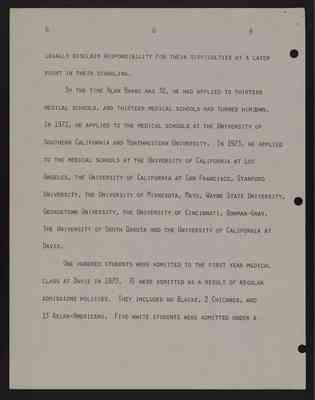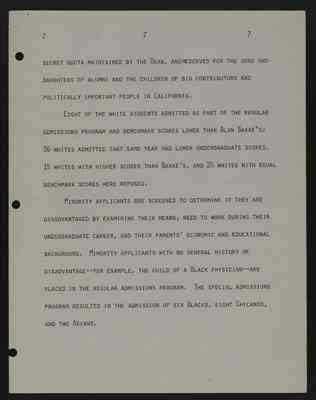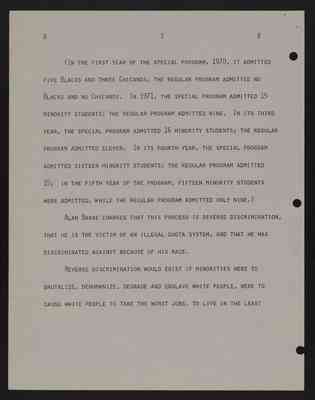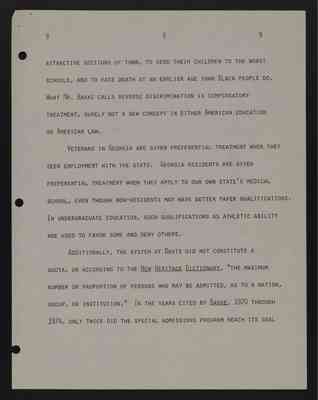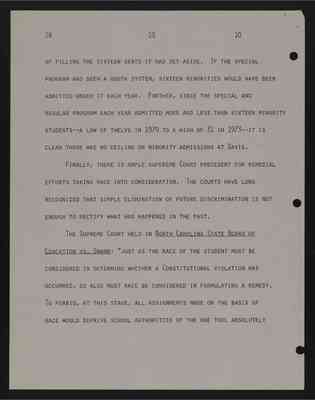Pages
6
6 6 6
Legally disclaim responsibility for their difficulties at a later point in their schooling.
By the time Alan Bakke was 32, he had applied to thirteen medical schools, and thirteen medical schools had turned him down. In 1972, he applied to the medical schools at the University of Southern California and Northwestern University. In 1973, he applied to the medical schools at the University of California at Los Angeles, the University of California at San Francisco, Stanford University, the University of Minnesota, Mayo, Wayne State University, Georgetown University, the University of Cincinatti, Bowman-Gray, the University of South Dakota and the University of California at Davis.
One hundred students were admitted to the first year medical class at Davis in 1973. 79 were admitted as a result of regular admissions policies. They included no Blacks, 2 Chicanos, and 13 Asian-Americans. Five White students were admitted under a
7
7 secret quota maintained by the Dean, and reserved for the sons and daughters of Alumni and the children of big contributors and politically important people in California.
Eight of the white students admitted as part of the regular admissions program had benchmark scores lower than Alan Bakke's; 36 whites admitted that same year had lower undergraduate scores, 15 whites with higher scores than Bakke's, and 20 whites with equal benchmark scores were refused.
Minority applicants are screened to determine if they are disadvantaged by examining their means, need to work during their undergraduate career, and their parents' economic and educational background. Minority applicants with no general history of disadvantage - for example, the child of a black Physician - are placed in the regular admissions program. The special admissions program resulted in the admission of six Blacks, eight Chicanos, and two Asians.
8
8
(In the first year of the special program, 1970, it admitted five Blacks and three Chicanos; the regular program admitted no Blacks and no Chicanos. In 1971, the special program admitted 15 minority students; the regular program admitted nine. In its third year, the special program admitted 16 minority students; the regular program admitted eleven. In its fourth year, the special program admitted sixteen minority students; the regular program admitted 15; in the fifth year of the program, fifteen minority students were admitted, while the regular program admitted only nine.)
Alan Bakke charges that this process is reverse discrimination, that he is the victim of an illegal quota system, and that he was discriminated against because of his race.
Reverse discrimination would exist if minorities were to brutalize, dehumanize, degrade and enslave white people, were to cause white people to take the worst jobs, to live in the least
9
9
attractive sections of town, to send their children to the worst schools, and to face death at an earlier age than black people do. What Mr. Bakke calls reverse discrimination is compensatory treatment, surely not a new concept in either American education or American law.
Veterans in Georgia are given preferential treatment when they seek employment with the State. Georgia residents are given preferential treatment when they apply to our own State's medical school, even though non-residents may have better paper qualifications. In undergraduate education, such qualifications as athletic ability are used to favor some and deny others.
Additionally, the system at Davis did not constitute a quota, or according to the New Heritage Dictionary, "the maximum number or proportion of persons who may be admitted, as to a nation, group, or institution." In the years cited by Bakke, 1970 through 1974, only twice did the special admissions program reach its goal
10
10 10 10
of filling the sixteen seats it had set aside. If the special program had been a quota system, sixteen minorities would have been admitted under it each year. Further, since the special and regular program each year admitted more and less than sixteen minority students—a low of twelve in 1970 to a high of 31 in 1973—it is clear there was no ceiling on minority admissions at Davis.
Finally, there is ample Supereme Court precedent for remedial efforts taking race into consideration. The courts have long recognized that simple elimination for future discrimination is not enough to rectify what has happened in the past.
The Supreme Court held in North Carolina State Board of Education vs. Swann: "Just as the race of the student must be considered in determing whether a constitutional violation has occurred, so also must race be considered in formulating a remedy. To forbid, at this stage, all assignments made on the basis of race would deprive school authorities of the one tool absolutely
